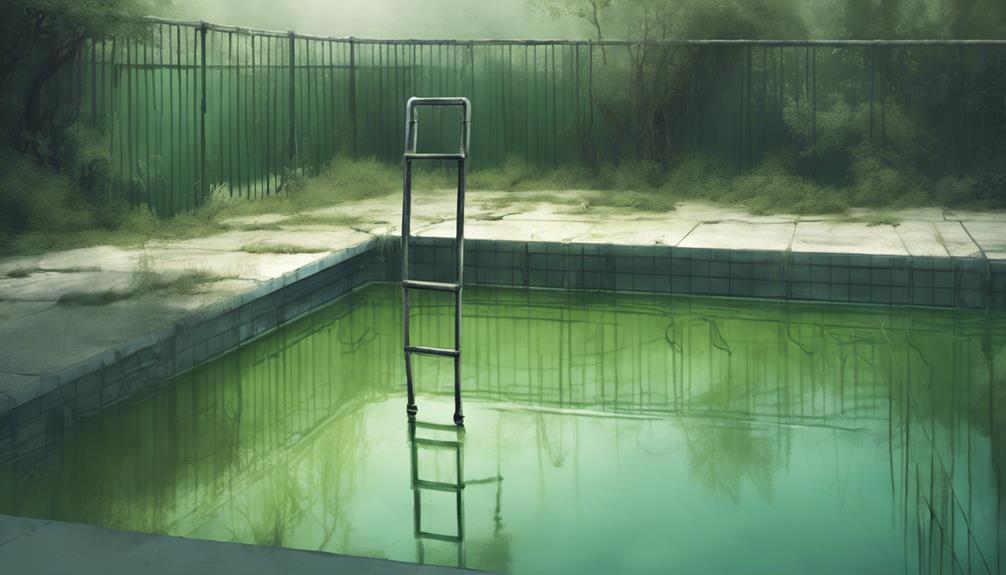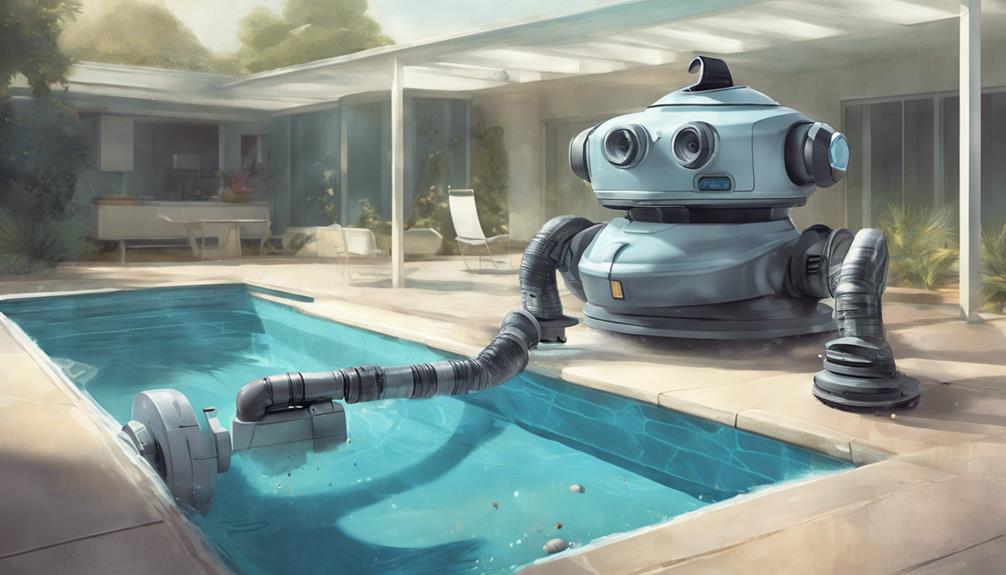Free chlorine is crucial for keeping pool water clean and safe by getting rid of harmful bacteria and preventing algae growth. Its importance in maintaining a healthy environment for swimmers cannot be overstated. Monitoring free chlorine levels using tests like FAS-DPD ensures the perfect balance. Understanding the various types of chlorine and controlling combined chlorine levels are essential tasks in effective pool upkeep. By consistently checking and adjusting chlorine levels, pool owners can avoid problems like algae growth and ensure proper sanitization. Discover more about the significant role of free chlorine in pool maintenance for a safe and enjoyable swimming experience.
Key Takeaways
- Free Chlorine essential for pool cleanliness and safety.
- Effective in killing harmful bacteria and preventing algae growth.
- Maintains a sanitary swimming environment.
- Key factor in achieving ideal water quality.
- Regular monitoring crucial for proper pool maintenance.
Importance of Free Chlorine
In pool maintenance, the importance of free chlorine cannot be overstated. Free chlorine plays a pivotal role in ensuring the cleanliness and safety of pool water by effectively killing harmful bacteria and microorganisms.
By preventing algae growth and other contaminants, free chlorine helps maintain a sanitary environment for swimmers, ensuring a pleasant and safe swimming experience.
Regular monitoring and maintenance of free chlorine levels are essential to guarantee that the pool water remains properly sanitized.
Understanding the significance of free chlorine in pool maintenance is essential for pool owners and professionals alike, as it is a key factor in achieving ideal water quality and ensuring the longevity of the pool infrastructure.
FAS-DPD Test Overview
Understanding the FAS-DPD test is fundamental for accurately evaluating chlorine levels in pool maintenance. This test specifically measures free chlorine (FCL) and combined chlorine (CC) levels, providing essential information for ensuring proper pool sanitation. The process involves adding DPD to a pool water sample, which reacts with chlorine to produce a pink color. By incrementally adding FAS drops until the pink color disappears, the CC levels can be determined. The number of drops required indicates the concentration of CC in the pool water. This detailed analysis enables pool owners to maintain optimal chlorine levels for effective sanitization.
| FAS-DPD Test Overview | |||
|---|---|---|---|
| Measures | Free Chlorine (FCL) | Combined Chlorine (CC) | |
| Process | DPD added to water sample | Reaction with chlorine produces pink color | Incremental FAS drops added until pink disappears |
| Indicator | Determines FCL and CC levels | Number of drops indicates CC concentration |
Types of Chlorine for Pools

Different varieties of chlorine play significant roles in maintaining pool cleanliness and balance. When it comes to pool maintenance, understanding the different types of chlorine is essential.
Here are some key types to explore:
- Free Chlorine (FCL): Chlorine available for sanitization.
- Combined Chlorine (CC): A breakdown product causing the typical chlorine smell.
- Total Chlorine (TC): The sum of FCL and CC, vital for pool balance.
Each type of chlorine serves a specific purpose in keeping your pool water safe and free from contaminants. Monitoring and maintaining the right balance of these chlorine types are necessary for a clean and enjoyable swimming experience.
Managing Combined Chlorine
Effective management of combined chlorine levels is vital for maintaining ideal pool sanitation and a pleasant swimming environment. Combined chlorine (CC) is an intermediate breakdown product that causes the distinct chlorine smell in pools.
Elevated CC levels above 0.5 ppm indicate insufficient free chlorine (FCL) levels, leading to potential health risks and reduced water quality. To address high CC levels, pool shocking is necessary to break down the combined chlorine compounds.
Properly managing CC through routine testing and adjustment of FCL levels guarantees effective pool sanitation. Regular monitoring of both FCL and CC levels is essential to prevent issues like algae growth and microorganism contamination, ultimately ensuring a safe and enjoyable swimming experience.
Total and Free Chlorine Monitoring

Monitoring total and free chlorine levels in your pool is essential for maintaining proper sanitation and water quality. To guarantee a safe swimming environment, consider the following key points:
- Regular Testing: Consistently test both total and free chlorine levels to prevent imbalances.
- Maintaining Balance: Keep total chlorine within the recommended range to prevent algae growth and bacterial issues.
- Immediate Action: Address any deviations from peak free chlorine levels promptly to maintain water clarity and safety.
Frequently Asked Questions
How Often Should I Test My Pool's Free Chlorine Levels?
Regularly test your pool's free chlorine levels to maintain sanitation. Aim for weekly testing during peak usage and weather changes, and biweekly during stable conditions. Monitoring free chlorine levels frequently maintains a safe swimming environment.
Can I Use Saltwater Chlorination Systems to Maintain Free Chlorine?
Saltwater chlorination systems can effectively maintain free chlorine levels in pools. These systems produce chlorine from salt, ensuring continuous sanitization. However, regular testing is essential to monitor and adjust chlorine levels for best pool maintenance and safety.
What Factors Can Cause Free Chlorine Levels to Fluctuate?
Fluctuating free chlorine levels in pools can result from factors like sunlight exposure, bather load, organic debris, pH fluctuations, and ineffective circulation. Regular testing, adjusting chlorine dosages, and maintaining pool conditions are key for stable chlorine levels.
Is It Safe to Swim if Free Chlorine Levels Are Too High?
As the adage goes, "safety first." Swimming in pools with excessively high free chlorine levels can irritate skin, eyes, and respiratory passages. It is advisable to avoid swimming until free chlorine levels are balanced for a safe and enjoyable experience.
How Can I Prevent Free Chlorine Loss Due to Sunlight Exposure?
To prevent free chlorine loss due to sunlight exposure, consider using stabilizers like cyanuric acid to shield chlorine from UV rays. Regularly test and adjust stabilizer levels, maintain proper pool pH, and limit pool exposure to direct sunlight during peak hours.
What Role Does Free Chlorine Play in Pool Maintenance?
Free chlorine for pool owners is essential for maintaining a clean and safe swimming environment. It helps kill bacteria, algae, and other harmful organisms in the water. By regularly testing and adjusting the free chlorine levels, pool owners can ensure that their pool water is properly sanitized and safe for swimmers.
How Does Pre-Swim Showering Impact the Levels of Free Chlorine in the Pool?
Preswim showering benefits pools by reducing the introduction of contaminants like lotions, sweat, and makeup. This helps to maintain balanced levels of free chlorine in the pool, preventing it from being quickly used up and ensuring that the water stays clean and safe for swimmers.
How does pre-swim showering impact the levels of free chlorine in pool maintenance?
Before entering the pool, preswim showering for healthy pools can significantly impact the levels of free chlorine. When swimmers shower beforehand, they remove body oils, sweat, and other contaminants that would otherwise react with chlorine in the pool water. This helps maintain higher levels of free chlorine for effective pool maintenance.
How Does Pre-Swim Showering Impact the Levels of Free Chlorine in a Pool?
Preswim showering for healthy pools is important to reduce the levels of contaminants like sweat, oils, and lotions that can react with chlorine in the pool water. By rinsing off before entering the pool, it helps to maintain the free chlorine levels, ensuring a cleaner and safer swimming environment.
How Does Pre-Swim Showering Impact Free Chlorine Levels in Pools?
Preswim showering for healthy pools is essential for maintaining free chlorine levels. When swimmers rinse off before entering the pool, it reduces the amount of sweat, oils, and other contaminants that can deplete chlorine. This helps to keep the chlorine levels balanced and ensures a safer and cleaner swimming environment for everyone.
Conclusion
In the intricate tapestry of pool maintenance, free chlorine serves as the vigilant guardian, warding off harmful contaminants and ensuring a pristine swimming environment.
Like a lighthouse guiding ships through turbulent waters, free chlorine illuminates the path to a safe and inviting pool setting.
Its meticulous management is akin to a steady hand on the rudder, steering towards equilibrium and cleanliness.
The significance of free chlorine cannot be understated in maintaining a harmonious balance in pool sanitation.










